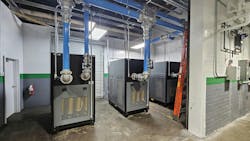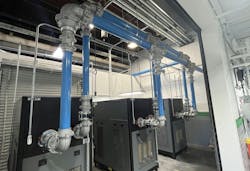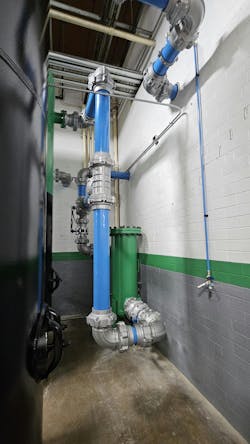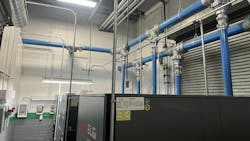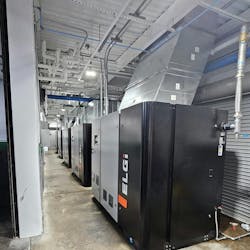Compressed Air System Overhaul Reduces Maintenance and Energy Costs
What you'll learn:
- How replacement of an aging compressed air system eliminated daily maintenance issues and reduced energy use.
- Important steps to follow when undertaking a compressed air system overhaul.
- Performance and operational improvements that can be achieved by overhauling a compressed air system.
Air compressor manufacturer ELGi and its distribution partner Pattons recently worked with Mann+Hummel, a developer of filtration systems for a range of industries, to overhaul the company’s compressed air system at its production facility in North Carolina.
Readily available clean, compressed air is necessary for powering equipment in the Mann+Hummel facility. It also plays an important part in chemical mixing and leak testing, critical to ensuring the quality of the company’s filtration products.
Steven Owens, Senior Manager of Manufacturing Engineering at Mann+Hummel, said in an interview with Power & Motion that the facility was experiencing a lot of issues with its old compressor system. He said there were five pieces of equipment that had been installed between the late 1970s and early 2000s that were showing their age.
The equipment was getting to a point where it was breaking down on a daily basis, causing downtime that impeded production and necessitated constant maintenance. “We were seeing a lot of issues with water in our air, not being able to provide quality air to our equipment in the plant and seeing a lot of machine downtime,” he said.
Air system issues like this not only cause downtime but can also lead to additional issues in the supply chain by potentially delaying product shipments and negatively impacting product quality.
Because of the larger implications these ongoing maintenance issues were causing, Owens and his team began looking at what they could do to address them and building a business case that showed “the amount of downtime, the amount of productivity we were losing, [and] the amount of value we were losing by stopping lines due to bad air quality in the plant.”
The company then began looking for a partner to engineer a new compressed air system. Owens said they wanted a system that would not require any maintenance and be “hands off for 5 years.”
Mann+Hummel chose to work with Pattons because it was able to provide the most cost-effective and creative solution, he said. “[Pattons was] the one group that hit every deliverable that we wanted and the way we wanted it and was willing to work in an innovative way to execute this with our air system.”
The Importance of Establishing Project Goals and Expectations Upfront
Pattons worked together with Mann+Hummel to create a plan for overhauling its compressed air system. “When you start on a project of this size, you really need a blueprint,” said Trey Carter, Systems Specialist at Pattons.
As he explained in an interview with Power & Motion, the original system had multiple compressors with different horsepower ranges as well as multiple entry points for compressed air into the system. “We started out with a full-fledged audit of the system to figure out how much air the plant was consuming throughout the day and [during] the different shifts that they operate,” he said.
Carter went on to say that for a project of this scope, “you really need to have a clear understanding of the customer’s needs and wants up front.” This ensures a customer’s expectations can be met and the project completed in a timely manner.
For its part, Mann+Hummel created a wish list of requirements for the new compressor system it would be installing. Reliability and maintenance were top priorities as well as the ability to monitor the system.
A system with built-in intelligence was an important factor, said Owens, not just from a performance monitoring perspective but an energy savings one as well. He said with the old compressed air system, there was no way to throttle it based on demand.
“If we wanted to save energy over a weekend, it physically took somebody going through and flipping switches to turn stuff off, then also having to remember to turn all that back on before we started back up,” he explained. “So, that was one of the things we wanted…a smart system, something that would be able to flex back and forth with the needs of the plant.”
Owens said there have been several leaps and gains in efficiency for air compressors over the last several decades the company wanted to capitalize on those.
When Mann+Hummel set out on the project to overhaul it compressed air system, it didn’t approach it with a specific type or brand of compressor in mind. “We wanted something that was cost effective for us and would get the job done and be serviced” as well as meet future needs for the facility.
Component Selection Ensures Optimized Compressed Air System Performance
Understanding Mann+Hummel’s goals for the project ensured Pattons chose the right products to meet the company’s need for a reliable, maintenance-free and energy-efficient compressed air system.
Taking these requirements in mind along with the performance needs of the facility, Pattons determined the best solution was to replace the company’s air system with new ELGi air compressors, refrigerated dryers, wet and dry tanks, and a smart controller. The products selected were those which enabled reliability and energy efficiency to be built into the system.
Five 200 hp ELGi EG-160 air compressors were installed at the facility — three with fixed-speed drives and two with variable frequency drives (VFD) that adjust motor speeds to a given load requirement. Carter explained that the VFD compressors help meet both high and low demands for flow to the system. “We’re only using energy for the amount of air that we need,” he said. “We can lower the plant pressure to an acceptable level and keep it steady with the variable speed technology.”
And because the η-V profile rotors for these compressors operate at low speeds, heat generation is reduced to prevent maintenance issues.
Three ELGi AR-2350 refrigerated dryers were installed as well to eliminate the moisture-related failures Mann+Hummel had previously experienced. The dryers are equipped with an automatic condensate drain, enabling them to remove moisture without air loss. This prevents water-related issues from occurring in the compressed air system that could otherwise cause damage to seals, cylinders and pneumatic tools, leading to misaligned and inconsistent product assembly.
Read "Compressed-Air Dryers" to learn more about dryer technology for compressed air systems.
The dryers include thermal mass control to provide energy savings during partial and no-load conditions. “Energy efficiency [played a big part in] the equipment that we used,” said Carter.
He said the smart controller was the icing on the cake as it allows for more hands-off control of the compressed air system as well as visibility into system performance. It provides alerts about oil temperatures and service needs as well as when machines are or are not running. The controller can also trend the data it captures so users can go back and see how the system has performed over time.
“It was amazing to see the autonomy that we have [with the controller] between the compressors cutting themselves on and off, sending notifications when maintenance is due ahead of time, instead of waiting for issues to crop up, and also getting that real world data,” said Owens. “Being able to take that [data] and show it to the people that we are asking for investment from really completes that financial justification circle for us.”
Reduced Maintenance and Energy Use Lead to Operational Improvements
Once the overhaul was completed, Carter said the difference in system performance could be seen immediately. Air quality improved and downtime has virtually been eliminated.
At the time of publishing, Mann+Hummel is over a year into utilizing the new system and has yet to experience a downtime event. “I’ve not had a call about our air system or air quality in the plant,” said Owens. “[Before the overhaul] I was averaging at least two to three calls a day.”
By undertaking the compressed air system overhaul, Owens said it “took a main pain point and a focus off of our plate in everyday operation. Not having to worry about the condition of air keeps me from having people tied up working on air compressors and spending budget on air compressors versus replacing equipment or repairing equipment that make actual parts for us.”
He said personnel who had to spend their time working on the compressors everyday have been redeployed to work on better value problems. “Are we moving material with air when we shouldn't be doing that because we know how much it costs. Are there different ways to handle air filtration?” These are the types of questions the team can now be asking and addressing to improve operations at the facility. “It has really helped us…to get back to working on the right things and not have to work on the facility types of stuff,” said Owens.
Energy savings were another key benefit Mann+Hummel achieved by overhauling its compressed air system. By selecting more energy efficient components for the system, Pattons was able to help Mann+Hummel reduce its energy consumption.
“Efficiency is on everybody’s mind in our industry,” said Carter, as more companies look to reduce their carbon emissions as well as energy costs. For a large horsepower compressed air system like the one at Mann+Hummel’s facility, use of energy efficient technologies and properly installing them can lower power consumption anywhere from 300-500 kW which equates to a lot of energy savings for a manufacturer.
“For us, efficiency all leads back to the dollar,” said Owens. “We have to do everything to control our cost in every aspect of our production [operations]. Anything we can do to lower our huge power bill is a big plus for us.
Read ELGi's full case study on the project with Mann+Hummel to learn more about the cost and energy savings achieved through use of efficient technologies, as well as more details on the project and compressed air system components utilized.
“We're projected for the first year [of using] this system to see around a $200,000 cost savings on our energy bill,” he continued. “That's around $17,000 a month on energy savings for us just related to the production of air. So, if I can take that big chunk out of our power bill, that makes us more cost competitive.”
“It's nice to see the end project and see all the wins inside Mann+Hummel just because of quality compressed air,” added Carter.
Both Carter and Owens said that if a company is looking to undertake a similar type of project, it’s important to have an open mind. As Owens put it, “The answer should always be a definite maybe.
“Too many times we look at things and say, ‘we can’t do this, or we can’t afford it.’ If you approach everything with a definite maybe, you kick over stones that you didn’t know you could do,” he said.
At the outset of the project, “we thought we knew exactly how we wanted to do this,” he said. But after looking at costs and the conditions at the time for some of the necessary components, the initial idea did not make financial sense or meet the company’s target timeline.
Owens’ other piece of advice is to investigate your options. “We are living in awesome times” he said in terms of the technology options now available. “You just need to find the tools and the talent to get what you need done.”
Partnering with Pattons enabled the company to assess its options and create a system that met its goals from a financial, performance and timeline perspective. Owens stressed the importance of Pattons being a partner, not just a supplier, for this project. Being able to collaborate with Carter and his team provided better understanding of what products would be a good fit and why, as well as the best setup for the final compressed air system to ensure it would meet Mann+Hummel’s project goals.
“Finding a reputable partner that knew what we wanted to do and had our best interests [in mind was key],” concluded Owens.
About the Author
Sara Jensen
Executive Editor, Power & Motion
Sara Jensen is executive editor of Power & Motion, directing expanded coverage into the modern fluid power space, as well as mechatronic and smart technologies. She has over 15 years of publishing experience. Prior to Power & Motion she spent 11 years with a trade publication for engineers of heavy-duty equipment, the last 3 of which were as the editor and brand lead. Over the course of her time in the B2B industry, Sara has gained an extensive knowledge of various heavy-duty equipment industries — including construction, agriculture, mining and on-road trucks —along with the systems and market trends which impact them such as fluid power and electronic motion control technologies.
You can follow Sara and Power & Motion via the following social media handles:
X (formerly Twitter): @TechnlgyEditor and @PowerMotionTech
LinkedIn: @SaraJensen and @Power&Motion
Facebook: @PowerMotionTech

Leaders relevant to this article:
